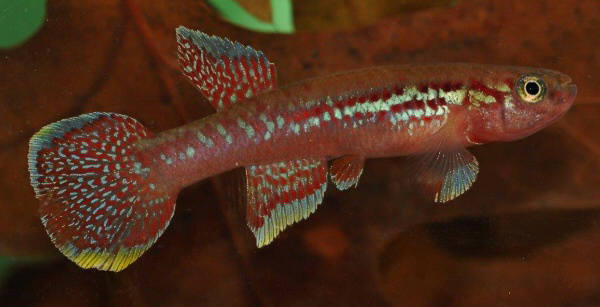Aphyosemion buytaerti Radda & Huber 1978

A.buytaerti FCCO
2013-02 - Zanaga
Photo courtesy of Christian Cauvet
Aphyosemion buytaerti Radda & Huber 1978

A.buytaerti FCCO
2013-02 - Zanaga
Photo courtesy of Christian Cauvet
| Meaning of Name |
After John Buytaert. |
||||
| First Description |
Radda A.C. & Huber J.H. 1978. Die Rivulinae des sudlichen Kongo (Brazzaville) I, Beschreibung von vier neuen Arten der Gattung Aphyosemion Myers. Aquaria 25 (12): 173-187 (181-183) fig. 11-12.. |
||||
| Size |
5 cm |
||||
| Meristics |
D = 12-13, A = 14-15, ll = 28-30 (+1-2), D/A = 1/6-8 (Radda & Huber 1978). |
||||
| Karyotype |
n = 19, A = 29 (Scheel 1981). |
||||
| Sub-Genus |
Mesoaphyosemion |
||||
| Group |
A.wachtersi |
||||
| Synonyms |
None. |
||||
|
Populations
|
BSWG 97 / 3 -
EBT 96 / 2 - Lendoungou, 2·8 km north of Maloundou.
|
||||
| Type Locality |
River Ekouma near the village of Ogooué between Zanaga & Voula II, central Congo. |
||||
| Distribution |
Despite efforts by Buytaert to find them in other locations they could not be found. Peter Tirbak tells me they were collected on his trip EBT 96 they collected them some distance to the north of Buytaert's locations. |
||||
| Habitat |
Found in a stream with forest cover in the centre of Ogooue. Measurements taken at 1400 hrs were Air temperature 19'C, water temperature 18'C, pH 6. Sympatric sp. included Aphyosemion schluppi, A.caudofasciatum, Hypsopanchax zebra, Hepsetus odoe (a predatory sp.), Phenacogrammus aurantiacus, Barbus akk.jae, Barbus sp.3, Ctenopoma nanum. |
||||
| Distinguishing Characteristics | |||||
| Colour/Pattern Variability | Low. | ||||
| History |
First discovered by Buytaert & Wachters on
the 23rd July 1978 at 1400 hrs at the type locality. |
||||
| Breeding Notes |
This sp. is reportedly difficult to spawn. Males
are very aggressive. Eggs are layed on top & bottom mops & take
15-20 days of water incubation. Egg production is reportedly only about
5 per day. It would however be better to leave the eggs with the parents
& allowed to grow on in the same tank. |
||||
| Diameter of Egg | Reported to be 'quite large'. | ||||
| Remarks |
At one stage they were reportedly lost to the
hobby although an odd pair does occur at BKA auctions at least in 1999. |